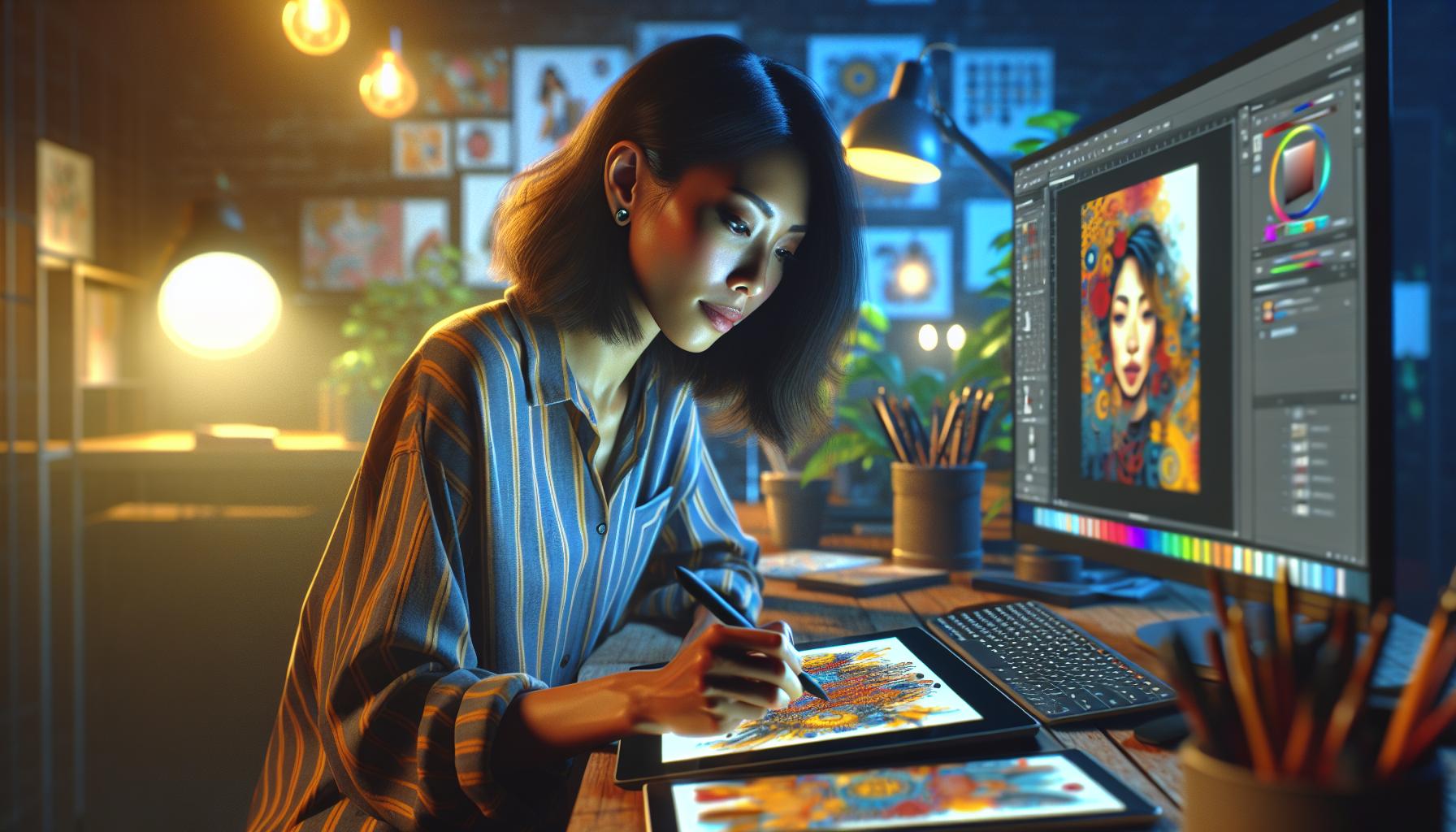Digital printmaking has transformed the way artists create and share their work. Gone are the days when traditional methods dominated the scene; now, technology empowers creators to explore new dimensions of art. I’ve found that this blend of artistry and innovation opens up endless possibilities for expression and creativity.
As I delve into the world of digital printmaking, I’m constantly amazed by how it bridges the gap between traditional techniques and modern technology. From vibrant color palettes to intricate designs, digital tools allow for a level of precision and experimentation that’s hard to achieve with conventional methods. Join me as I explore the fascinating journey of digital printmaking and uncover its impact on the art community.
- Digital Transformation: Digital printmaking merges traditional art techniques with modern technology, enabling artists to explore new creative avenues.
- Versatile Techniques: Key methods include inkjet printing, laser printing, and digital screen printing, each offering unique results and flexibility for various mediums.
- Software Empowerment: Specialized design and print management software enhance artistic capabilities and streamline production processes, allowing for efficient workflow.
- Cost-Effectiveness: Digital printmaking reduces overhead costs and allows for smaller print runs, making it financially accessible for artists while maintaining quality.
- Quality Control: Artists can achieve superior color accuracy and print consistency through digital tools, ensuring high-quality outputs suitable for exhibitions and sales.
- Challenges: Despite its advantages, digital printmaking requires significant investment in equipment and a steep learning curve for mastering software and techniques.
Digital Printmaking
Digital printmaking merges traditional artistic methods with advanced technology. This process utilizes digital tools to create prints, enabling artists to enhance their creative expressions through various techniques.
Digital printmaking encompasses several methods, including inkjet printing, laser engraving, and thermal transfer. Each technique delivers unique results, allowing for experimentation with different materials and surfaces.
Artists benefit from increased precision and consistency in their work. Color management achieves superior results, producing vibrant images that maintain integrity across multiple prints.
Many artists embrace digital printmaking for its versatility. This medium permits alterations and revisions without significant material costs. Additionally, limited editions and personalized prints offer new revenue streams.
The impact of digital printmaking extends to accessibility. Artists can easily share their work through online platforms, reaching broader audiences. Collaborative projects also thrive in this digital landscape, fostering community engagement.
Digital printmaking revolutionizes artistic creation and distribution, blending innovation with traditional practice while unlocking new avenues for expression.
Techniques In Digital Printmaking

Digital printmaking encompasses various techniques that empower artists to achieve remarkable results. Below, I detail key methods utilized in this innovative field.
Inkjet Printing
Inkjet printing serves as a primary technique in digital printmaking. This method relies on tiny droplets of ink ejected from nozzles onto paper or other surfaces. Artists can create high-resolution prints with intricate details and a broad range of colors. Inkjet printing is particularly valued for its ability to handle various materials, including canvas, fine art paper, and specialty substrates. The use of pigment-based inks enhances longevity and vibrancy, making prints suitable for galleries and exhibitions.
Laser Printing
Laser printing stands out for its speed and efficiency in digital printmaking. Utilizing a laser beam to fuse toner onto paper, this method produces crisp and sharp images. Artists appreciate laser printing for its capacity to create bold graphics and text, which suits commercial applications and art reproductions. Moreover, the precision of laser technology allows for detailed line work and consistent quality across multiple prints, making it a reliable choice for artists seeking high-volume production.
Digital Screen Printing
Digital screen printing merges traditional screen printing techniques with modern digital technologies. This approach enables artists to print directly onto various surfaces, from textiles to ceramics. By using digital files, artists can control color layering and achieve intricate designs without the time-consuming setup typical of traditional screen printing. Digital screen printing facilitates low-volume runs and customization, catering to artists interested in personalizing their work and products while maintaining high-quality standards.
Software And Tools For Digital Printmaking

Digital printmaking relies heavily on specialized software and tools that enhance the creative process. These tools streamline design, improve production efficiency, and elevate the overall quality of prints.
Design Software
Design software plays a crucial role in digital printmaking, allowing artists to conceive and manipulate their artwork digitally. Popular options include:
- Adobe Photoshop: Essential for photo editing and raster-based designs, it offers advanced features for manipulation and layering, crucial for creating intricate prints.
- Adobe Illustrator: Ideal for vector graphics, it enables artists to create crisp illustrations and logos, maintaining quality at any scale.
- CorelDRAW: Known for its user-friendly interface, it provides powerful vector editing features alongside tools for layout and typography.
- Procreate: A favorite among digital illustrators, it allows for intuitive drawing on tablets, making it easy to draft concepts on the go.
These software options provide diverse capabilities, empowering artists to experiment with color, texture, and composition.
Print Management Software
Print management software helps in organizing and streamlining the printing process, ensuring efficiency and consistency. Some widely used solutions are:
- Printful: A print-on-demand service that integrates with e-commerce platforms, enabling artists to sell designs without worrying about inventory.
- FlexiPrint: This software manages workflow from design to printing, offering automation features that save time and reduce errors in production.
- RIP Software: Raster Image Processor (RIP) software takes digital files and converts them into formats optimized for printing, enhancing color accuracy and detail reproduction.
- Wasatch SoftRIP: Focused on large-format printing, it offers tools for color management and layout, ensuring high-quality prints and efficient use of materials.
These print management options streamline the production process, enhancing the overall experience of digital printmaking.
Benefits Of Digital Printmaking

Digital printmaking offers numerous advantages that significantly enhance the creative process for artists. This technology not only streamlines production but also expands artistic possibilities.
Cost-Effectiveness
Cost-effectiveness stands out as a key benefit of digital printmaking. It reduces overhead costs, eliminating the need for extensive materials and significant labor associated with traditional methods. Smaller initial print runs become viable, allowing artists to avoid large inventory storage expenses. Additionally, quick turnaround times lead to savings in labor costs, making digital printmaking a financially prudent choice for artists and studios alike.
Versatility
Versatility plays a crucial role in digital printmaking. Artists can work across various mediums, including paper, fabric, and wood, seamlessly adapting designs for each surface. The technology permits easy revisions and modifications, fostering creativity without the fear of waste. With options for personalization and customization, artists can create limited editions or unique pieces to cater to different audiences, thus expanding their market reach.
Quality Control
Quality control becomes simpler with digital printmaking. Artists maintain precise color management through software tools, ensuring consistent results across prints. The high-resolution output from inkjet and laser printing guarantees detailed images with vibrant colors. Artists can inspect proofs digitally before full production, allowing for immediate adjustments and reducing errors. This level of control enhances overall print quality, meeting the high standards expected in the professional art world.
Challenges In Digital Printmaking
Digital printmaking presents distinct challenges that artists encounter while navigating its complexities. Addressing equipment costs and the learning curve is crucial for maximizing its potential.
Equipment Costs
Investing in high-quality equipment for digital printmaking involves significant financial commitment. Professional-grade printers, which can exceed $10,000, often produce superior prints not achievable with consumer models. Additional costs arise from purchasing specialized inks, papers, and software, which further drive up overall expenses. Artists must analyze their budget carefully to determine the return on investment before committing to expensive equipment purchases.
Learning Curve
Mastering digital printmaking requires familiarity with various software and techniques, presenting a steep learning curve. Artists might spend months developing proficiency in design programs like Adobe Photoshop or CorelDRAW. Understanding printer settings and color profiles also poses challenges, as mismatches can lead to unexpected results. Continuous adaptation to technological advancements and updates in printing methods is essential for staying relevant in this fast-evolving field.
Digital printmaking has opened up a world of creative possibilities that I find truly inspiring. It’s exciting to see how artists can blend traditional techniques with modern technology to create stunning works of art. The ability to experiment with various methods and materials not only enhances artistic expression but also makes art more accessible to a wider audience.
While there are challenges like equipment costs and the steep learning curve, the rewards are well worth the effort. As I continue to explore this dynamic field, I can’t help but feel optimistic about the future of art in the digital age. I encourage fellow artists and enthusiasts to embrace digital printmaking and discover the unique opportunities it presents.



